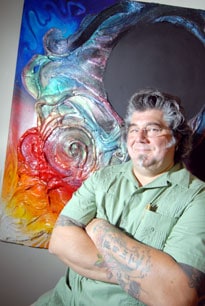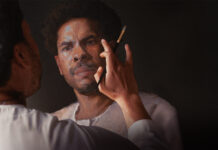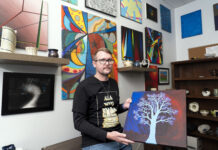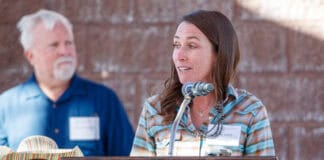Shotsie Gorman is a walking encyclopedia and an individual book of faith.
Though he hasn’t a degree to speak of, his persistent drive to find the correct answer or ask the right questions sends him on endless travels, whether awe-inspiring or disconcerting.
Larson Newspapers
________________
Shotsie Gorman is a walking encyclopedia and an individual book of faith.
Though he hasn’t a degree to speak of, his persistent drive to find the correct answer or ask the right questions sends him on endless travels, whether awe-inspiring or disconcerting.
It’s that same drive which brings Gorman and his family to Sedona.
Taking a break from working in his art studio on Oak Creek Boulevard, Gorman, 55, still finds ways to incorporate abstract ideologies into conversation.
A few moments alone and it’s easy to recognize his concepts are not regurgitated theory from texts, rather well thought out and instinctual.
As a combatant against intellectual
ventriloquism, he proves he’s no dummy.
Gorman recalls his childhood as one of abuses and severe misunderstandings.
His father was a police officer who expected his son to follow in his footsteps, he says.
When he chose poetry over police work, his father was disappointed.
“Art was a euphemism for homosexuality,” Gorman explains, sarcastically. “The most intellectually stimulating thing to read in our house was the TV Guide.”
Unbeknown to his father, Gorman would follow in a pair of footsteps — those being of poet Allen Ginsberg.
He remembers Ginsberg frequenting his Patterson, N.J., neighborhood, one time sitting in front of his mother and him on a bus.
“Do you know who that is? That’s a famous poet,” Gorman remembers his mother saying.
Decades later, in 1998, Gorman won second place in the Allen Ginsberg Competition with his poem “Grandpa’s Kitchen Tricks.”
In his early 20s, Gorman moved to Manhattan, N.Y., for its art scene. He thought New York would be identical to Paris at the turn of the 20th century.
He was wrong.
Instead, all people talked about was sex and real estate, he says.
To make ends meet in New York, artisans took on different trades.
“If you were a sculptor, you worked as a carpenter. If you were an artist, you were an electrician. And if you were a singer or an entertainer, you waited tables,” he says. “It was our union. It was camaraderie.”
Since Gorman was a sculptor, he was a carpenter. But he was learning he was much more than that.
Classic of this New Jersey native, Gorman uses metaphor and analogy within the context of most discussions.
He doesn’t do this to sound arrogant, instead he does it to relate the past with the present and show how history repeats itself.
Smiling and pulling his clasped hands outward, Gorman begins talking about English explorer James Cook and his landing in New Zealand in 1769.
His palms are an open book from which he doesn’t read, but he recites from memory how one of Cook’s men, an artist, began sketching the country’s flora and fauna.
He says when New Zealand’s Maori tribe approached the ship’s crew, the artist sketched a man, including the traditional facial tattoo he wore.
The Maori looked at the drawing and shook his head, replacing the sketch with his own drawing of just the single tattoo, Gorman adds.
The man’s identity didn’t come from his body as much as it came from the symbol upon his face. The body was nothing other than a container for his soul, he explains.
Consequently, Gorman’s soul started developing immensely during his own 27-year tattoo career that he began when he was only 26.
Like most things in his life, tattooing came to him unexpectedly.
He was working as an apprentice sculptor when he noticed a poorly inked tattoo on his mentor, Mike Bakaty.
After a little research, Gorman became intrigued by tattoo history and “how to.”
When he wasn’t sculpting or reading, he built up an unusual portfolio from pictures in old wedding albums he found at flea markets, he says.
He entered the tattoo world already an accomplished artist, skipping the all-important yet tedious apprenticeships some artists are nurtured under.
Gorman reigned in the tattoo world for nearly three decades, eventually selling two New Jersey tattoo businesses bearing his name.
Meanwhile, he worked as a tattoo consultant for films, toured the talk-show circuit and attended an apprentices’ workshop at Russia’s first tattoo convention.
Some look at tattooing as a working-class art, Gorman says.
More so, it was a tradition of transformation, a rite of passage and shamanism, he adds. All the while, tattooing was a way to add one more piece of art into his arsenal.
As a child, Gorman battled what he calls a “centuries-old history of abuse, alcoholism and drug addiction.”
He says his interest in expanding his mind in the art world, instead of chemical euphoria, was his karmic salvation.
Today, Gorman is starting his life over — yet again.
Happily married with three children — one en route to college, another fresh out of diapers — Gorman says he wants to ride the waves of the “overlapping concentric circles that ripple in Sedona.”
He has literally rid himself of material possessions to move himself to Sedona where he believes a community of “letting go” allows a person to gain so much more.
Whether it means putting strings of words into poetry or creating art, letting out and eliminating fear is healing and growth.
“I let go of everything. I’m 55 and I’m still letting go,” he says.






















